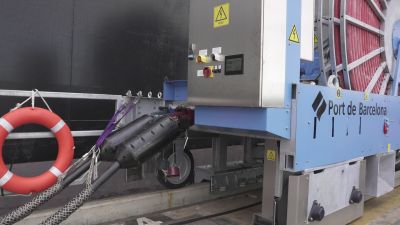Feature, Freight News, Sea
Offshore power goes live in Barcelona
[ September 26, 2024 // Chris Lewis ]The Port of Barcelona connected its first ship to the onboard power system (OPS) at its BEST terminal on 24 September, the first emission-free port of call for a container ship.
The OPS was completed this August with a cable management system to connect the OPS to the wharf.
The ship was the 24,000TEU MSC Mette. According to the port, the connection and provisioning process was successful and ran smoothly.
The system has been custom-designed to avoid interfering with container loading and unloading operations.
Once connected, it was also possible to test synchronisation between the OPS and the ship’s electrical systems, which worked flawlessly it added. The power needs of each ship can vary depending on factors such as size or number of refrigerated containers it carries, and one of the key functions of the OPS is that it adapts the energy it receives through the medium-voltage network to these needs. In this case, the OPS supplied the MSC Mette with a total of 103,200 kWh.
The first two years of operation of the OPS, which is part-financed by the Sustainable and Digital Transport Support Programme under the Recovery, Transformation and Resilience Plan, is a pilot phase that will provide real-time data and experience concerning the operation of the system and the best way to integrate ship power supply into port operations. Armed with this knowledge, the ort will continue to roll out the OPS under its Nexigen plan, which aims to electrify the main wharves at the Port of Barcelona over the next five years.
Port of Barcelona president Lluís Salvadó commented: “Connecting a container ship to the electricity grid for the first time is a key step forward in the rollout of the Nexigen plan and the decarbonisation of port activity. We are effectively already eliminating emissions generated by ship engines, a process that will be greatly increased once we roll out the rest of the OPS thanks to the experience that this pilot test will provide us.”
The rollout of the €200 million Nexigen plan will continue with the entry into service of the first OPS in a ferry terminal, scheduled for this winter. It also involves building a new electrical substation from which a new medium-voltage network will be deployed throughout the port, including an underwater pipeline to connect the supplies from the Energy Wharf and the Adossat Wharf, making it possible to electrify all cruise, ferry and container terminals by 2030.

Tags: Hutchison Ports BEST; Port of Barcelona












